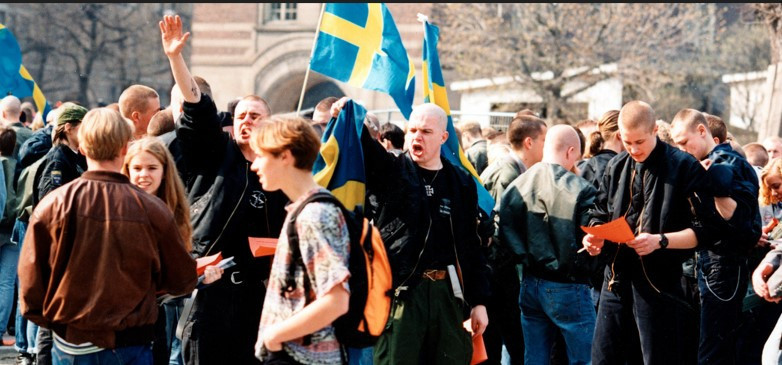Sweden is an interesting country. A country out of this world in some respects. For example, he swam against the tide during the Covid-19 pandemic. While everyone else closed, Sweden remained largely open. Schools, cafes, life… Sweden was working. It was the exception.
A dream of clarity. This is something Sweden always boasts about. A state that sees closure as a bogeyman, prioritizing not only the open air but essentially the open mind.
There is one more scale that makes this Scandinavian country different and exceptional. Assembly arithmetic…
Or should it say ‘there was’.
No more.
*
Sweden had some sort of immunity to the far right. In the 2000s, while the far-right parties won successive victories in many countries in Europe, the doors of the Swedish parliament Riksdag remained largely closed to the country’s domestic and national extreme right.
Until the September 11, 2022 elections…
Until that day, the extreme right in Sweden had never been able to show the presence it wanted in parliamentary arithmetic. So much so that the far-right movement in neighboring Denmark, which it resembles in many respects, entered the parliament in 2001, while the far-right party, which was founded in Sweden in 1988, waited until 2010 to have a seat in the Riksdag. That year, they had garnered 5.7 percent of the vote.
Even this rate set the alarm bells off in Sweden. Parties from right and left allied against them in parliament; restricted their range of motion. The dominant politicians of the time thought that the far right was against Sweden’s famous philosophy of ‘openness’.
But two weeks ago, the Sweden Democrats (Sverigedemokraterna, SD), representing the far right, changed the arithmetic in Stockholm.
SD, led by Jimmie Akesson, received 20.6 of the votes; It became the second party after the Social Democrats, who entered the election in the seat of power and increased their votes by two points to 30 percent.

*
Sverigedemokraterna, or Sweden Democrats, is a movement that some of its founders are Nazi admirers of, as the party itself admits. When the party entered Parliament for the first time in the 2010s, this issue caused serious discomfort in Sweden and right before the 2018 elections, right-wing parties declared that they would not work with them no matter what.
But here’s the politics…
Parties on the centre-right, especially the conservative right, have converged with the far right over time. They acted together on many issues and expressed a common view.
And we came to 2022 with an alliance that includes the far right.
What will happen now?
The ruling Social Democrats will fall from power, although they have increased their votes, as the votes of the blocks, similar to the one in Turkey, are currently effective rather than individual parties in Sweden. Because the bloc they were in was defeated by the other side, even by a narrow margin.
But the SD will still not be part of the government. Because the Liberals, one of the main elements of the bloc, declared that they would not be included in a government that included them. That’s why the SD will stay out and be part of the government, if not the government. They have already published a 100-item demand text.
*
So, how did the extreme right, whose essence was not read in the Riksdag for a period, come to the level where every five Swedes could vote?
First, they dealt with the overwhelming anti-immigration sentiment across Europe (a particularly explosive theme there, given that one in four Swedes has an immigrant background today). So much so that the leader of the party, Jimmie Akesson, came all the way to Turkey, and was deported when he handed out a leaflet to the refugees at the Edirne Pazarkule border gate saying “Don’t come to Sweden”.

Secondly, the rise in the cost of living and energy, as well as the reaction and antipathy towards immigrants observed in the majority of the Swedish electorate, facilitated the SD’s march to power.
And the party finally addressed the lack of ‘order’ in the country. SD produced an effective policy through increasing gang showdowns and murders in the middle of the street. (Interestingly, in a geography far from Sweden, in the Philippines, authoritarian politician Rodrigo Dutarte came to power with a similar policy in 2016 and held on there for six years.)

There is also this: the SD accepted the Nazi tendencies of its founders in terms of transparency, while at the same time it exported some radical elements within itself to improve its image. He also brought himself closer to the center in Sweden’s last major national debate, supporting the country’s decision to join NATO. But above all, it normalized its existence by acting on many issues with the existing right-wing parties.
Here is the issue.
What has this normalization brought to the centre-right? Maybe in a few everyday problems, it’s the opportunity to save the day by making SD say the harsh words he couldn’t say…
What happened after all?
The SD became the second party of the country and the first party of the Swedish right, by getting votes from the right-wing parties (and a little from the centre-left) with which it is allied. By melting the center…
The victory of the far right.
Sweden was sort of the last bastion against the far right. Now that castle has fallen too.
*
This is a political trend.
Freedom Party in Austria…
People’s Party in Denmark…
In the Netherlands, Geert Wilders’ Freedom Party, also recently Thierry Baudet’s Democracy Forum…
Marine Le Pen’s National Front, which nearly won the presidential election in France; In addition, Eric Zemmour, the surprise candidate of the last election, to the right of Marine Le Pen…
Progressive Party in Norway, Real Finns in Finland…
Vox in Spain, Chega in Portugal (both in the third party position of their own parliament)…
Matteo Salvini’s League Party, which was quite popular in Italy for a while…
The Alternative Party for Germany with serious potential despite not being able to show its presence in the last elections in Germany…
They came from the far right and, although they stumbled at times, left their mark on Europe’s 2010s.
They will also be effective in the 2020s.
Now Sweden Democrats have been added to them.
*
Another party is next.
Another victory of the far right…
In the elections to be held this Sunday, the rising leader Giorgia Meloni is expected to come to power in Italy.

Meloni, leader of the Brothers of Italy Party, is the last great leader of the far right in Europe. It is estimated that Meloni, supported by former prime minister Silvio Berlusconi and the former favorite of the Italian far right, Matteo Salvini, will establish the far-right government in the country after the Second World War, that is, after Mussolini.
The roots of Meloni’s party go back to Mussolini anyway.
But right now, voters do not look at whose origins go to where.
The energy crisis, the high cost of living, immigrants, the war in Ukraine, the escalation in crime It’s time for demagogues all over Europe to show up.
All this demagogy will serve to strengthen authoritarian tendencies. Women’s rights will be curtailed, especially through abortion, anti-LGBT-I will rise to the extreme, and finally, Europe’s dream of multiculturalism, which has been seen for a while but long forgotten, will now be buried in the fog.
*
Italy has a dominant atmosphere. Many Italian voters have long felt that their country has been pushed around and not respected enough by the rich countries of Europe. This weather is more intense these days.

Meloni processes this air. On the other hand, she says that everything bad in the country stems from the left, that they left the country in the hands of the rich countries of Northern Europe.
For example, he says that he will not hand over the fate of Rome to the energy companies in Berlin or Amsterdam. Meloni is also gaining votes for his far-right party from this point.
But there is also this: The far right is also on the rise in Berlin and Amsterdam.
It is also rising in Budapest and Warsaw from the Eastern Bloc.
It is also rising in Stockholm, whose basic philosophy is openness and tolerance.
It rises both in the north and south of the continent.
It rises in both the rich and the poor.
I guess Europe wants to go to extremes anyway.
